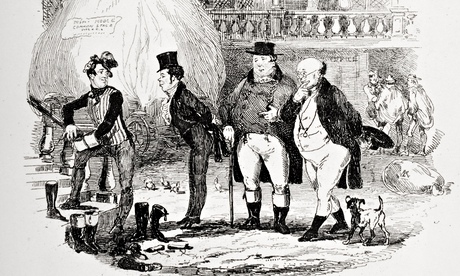
It was in the long, hot summer of 1975, after finishing university and before the shades of the prison-house – finding a job – closed in that somehow, for reasons I cannot now recall, I found myself reading The Pickwick Papers in my parents’ sun-dappled garden. My Penguin copy is punctiliously dated 8 July that year (I used to do that sort of thing). The spine is completely broken at page 476 and there are stains (suntan lotion? Coca-Cola?) on the pages, so I must have been enthralled. It was my first Dickens and, as my school and university careers had been taken up by set books, it was a liberation. Even Christmas at Dingley Dell is infused with sunshine in my memory.
I still remember the surprise that Dickens could make me laugh out loud, and that is what made me love it. I had read humorous authors – Wodehouse, Thurber – but I had not expected it from a Sunday afternoon telly serial classic. There was Mr Jingle’s cricket match – “Played it! Think I have – thousands of times … exciting thing – hot work – very”; and Sam Weller and his dad composing the fatal Valentine’s card: “Wot I like in that ’ere style of writin’ … is there ain’t no callin’ names in it – no Wenuses, nor nothing o’ that kind … You might jist as well call her a griffin, or a unicorn or a king’s arms … which is werry well known to be a collection o’ fabulous animals.”
Best of all is the trial scene: “‘Yes, I have a pair of eyes,’ replied Sam, ‘And that’s just it. If they wos a pair o’ patent double million magnifyin’ gas microscopes of hextra power, p’raps I might be able to see through a flight o’stairs and a deal door; but bein’ only eyes, you see, my wision’s limited.’”
It is a young man’s book, of course, lifting themes and ideas and characters – Jingle is apparently based on the recently deceased comic actor Charles Mathews – but written with tremendous verve and style by a 24-year-old on the make. How Dickens must have aggravated jealous older colleagues. The book started off as the brainchild of a relatively well-known illustrator called Robert Seymour, hoping to cash in on the craze for humorous cockney sportsmen such as those in Pierce Egan’s Tom and Jerry. But Dickens had other, better ideas. Within three days of meeting the neophyte author and finding his drawings criticised, the depressed Seymour walked out into his Islington back garden and shot himself. Seymour’s successor, Robert Buss, was no better – his drawing of a cricket match shows he knew even less about sport than Dickens did – but then the author found his perfect illustrator: Hablot K Browne – known as Phiz – created Sam Weller and the book took off. Dickens never looked back.
My other reason for loving it has always been its romantic, prelapsarian, brilliantly vivid portrait of late Georgian England, just before the railways changed everything – easy to forget that the book was two-thirds complete before the teenage Victoria came to the throne. The exuberance of the writing shows the fun Dickens was having. The Eatanswill election chapter is derived from his coverage of an election in Ipswich. It is a satire on reform-era politics. But as Norman Gash, the great historian of the period, says, it is actually a pale and euphemistic version of contemporary politics. The book’s darkest episode, Pickwick’s imprisonment, was clearly coloured by Dickens’s father’s time in the Marshalsea for debt a few years earlier. You can read it for the history – as I probably started off doing – and you can read it for the fun. It started me reading Dickens – always a good thing – and, despite his later, greater, books, it remains my favourite.
It would be wrong to say The Pickwick Papers made me want to be a journalist, as the chances of that happening seemed vanishingly small at the time I read the book, but the idea of conveying what events were like was certainly encouraged by it. When I eventually became a journalist, watching local worthies, politicians and judges, it sometimes seemed they were not so very different from their Dickensian predecessors, though perhaps the acoustics were better: “Nathaniel Daniel or Daniel Nathaniel?” “No my lord, only Nathaniel.” “What did you tell me it was Daniel for then, sir?”
My interest in the period was coloured in by Dickens. Perhaps that is why my recent books are set in those decades: a book about British politics and society in 1846, and one about the Victorian poisoner William Palmer, who was executed in front of a crowd of 30,000 people in 1856.
Dickens was fascinated by the case too, especially by Palmer’s seeming ordinariness. “Everywhere I see the late Mr Palmer … Mr Palmer sits next to me at the theatre; Mr Palmer goes before me down the street … I vow to God I can see nothing but cruelty, covetousness, calculation and low wickedness,” he wrote, describing him as the worst criminal ever to stand trial in the Old Bailey dock. Palmer’s defence barrister, Serjeant Shee, gave a good imitation of Serjeant Buzfuz, and the judge, lord chief justice Campbell, was not much better than Mr Justice Stareleigh in Pickwick’s case, so perhaps it is no wonder I was drawn to the case too: as a great, rich slice of rascally early Victorian England.
Some years ago, my wife gave me a 1930s facsimile copy of Pickwick in its monthly instalments, complete with resonant between-the-wars advertisements (“I have used your whisky consistently for the last 25 years and do not know what I should have done without it”), but in a way it’s too precious to read. I’d take the battered Penguin to my desert island.

